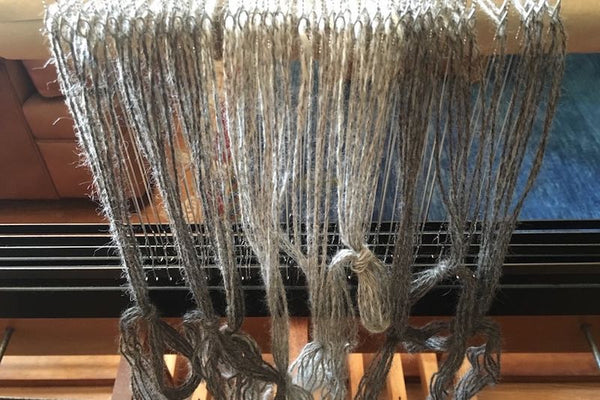Fast & Free shipping on all US orders.
Shop
Dyes

What do you need to know to choose your sett?
September 16, 2016 3 min read
Field Notes
I have come to the point in my current weaving project when I have to just accept that I messed up. Last week I tried to adapt my weft pattern for a warp that was sett a little too wide. I was, at first, enchanted by the new design, but as the weft went on I was never in love with the way it felt.
The warp, being too loose, gave the feeling that my work might snag or fall apart in the normal, everyday use of the table runner. This is yarn that I made myself from raw fiber I washed myself. I will not compromise on quality now. The finished piece has got to embrace me with a feeling of accomplishment, not regret. There is no other way. The warp must be fixed.
So, I reversed the weft, untied the warp from the front bar, and carefully removed it from the reed. Obviously I was too quick in calculating my sett the first time around, so let’s back up and take a closer look.
What is sett?
Sett is the number of yarn ends that fall within one inch on the reed. In a 10 dent reed, there are ten open spaces for every inch. If I thread each space with two ends, my sett is 20 ends per inch. Here is my go to chart for warp sett reed conversion.
What do you need to know in order to choose your sett?
- How many Yards Per Pound (YPP) are in the yarn you will be using?
- What do you want the piece to feel like?
How do you determine your desired sett?

- Calculate the maximum sett for a balanced weave (plain weave) using Ashenhurst's formula above or simply following a chart. When in doubt, sample.
- How do you want the fabric to feel? The maximum sett will yield a tight or dense fabric. If you want it to feel looser, reduce the number in the sett. The gauge of your weft yarn also plays a role. As a general rule:
- If your weft yarn is the same YPP as your warp it will balance.
- If your weft is a lighter gauge your piece will be warp-faced.
- If your weft is heavier gauge it will be weft-faced.
So, where did I go wrong, and what is the correct sett for my project? I am using two different gauges of yarn in the warp, intentionally. I have a center stripe of silver yarn at about 800YPP flanked by two dark gray stripes of about 950YPP. I want the dark gray to balance, and the center to be warp faced. My mistake is that I calculated my sett using the gauge of the center stripe. In hind sight, my mistake is obvious, but at the time. . .my vision was not so clear. So here we are. I will re-sett the warp through the reed with the dark gray yarn balancing, and that should do the trick. I'll let you know.
Field Notes go behind the scenes to peak at the raw, unrefined, and real-time process of making. Through these blog posts I hope to capture the naturally recurring themes that keep a creative lifestyle buzzing, and I invite you to apply the unfiltered energy of creativity to your own work, in your own way.
3 Responses
Linda Peterson
June 23, 2017
Great info, thanks Linda
susan shaw kroll
June 23, 2017
what would happen if you sett the dark grey and the light grey at different setts?
Leave a comment
Comments will be approved before showing up.

Join Our Newsletter
Our weekly newsletter is plain and simple.
Just one or two headlines from our Mill Shop, so you can be the first to grab limited editions and special offers.



Michele Williams
September 10, 2017
Doesn’t Ashenhurst’s formula give the wpi, which you would divide by 2 to get the sett?